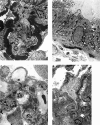Dense deposit disease: clinicopathologic study of 32 pediatric and adult patients
- PMID: 18971369
- PMCID: PMC2615696
- DOI: 10.2215/CJN.03480708
Dense deposit disease: clinicopathologic study of 32 pediatric and adult patients
Abstract
Background and objectives: Dense deposit disease (DDD) is a rare disorder that most commonly affects children. This study reports the largest North American series addressing clinicopathologic and outcome differences in children and adults.
Design, setting, participants, & measurements: Thirty-two patients with DDD were analyzed from the archives of Columbia University between 1977 and 2007. Characteristic intramembranous electron-dense deposits defined all diagnoses.
Results: The cohort included 14 children (<16 yr) and 18 adults, with 39% of adults >60 yr. The female/male ratio was 1.9. At presentation, the mean 24-h urine protein was 4.6 g, nephrotic syndrome was present in 33%, renal insufficiency in 59%, and hematuria in 87% of patients. Compared with adults, children had lower incidence of renal insufficiency and were more likely to have reduced C3. Histologic pattern included membranoproliferative, mesangial, endocapillary, and crescentic glomerulonephritis. Treatment included immunosuppression (IS) alone in seven, renin angiotensin system (RAS) blockade alone in six, and combined IS/RAS blockade in 11. On follow-up (mean 63 mo) available in 27 patients, 26% had complete response, 48% had persistent renal dysfunction, and 26% had ESRD. Correlates of ESRD were older age and higher creatinine at biopsy, the absence of combined IS/RAS blockade therapy and the presence of subepithelial humps, but not histologic pattern. On multivariate analysis, age and creatinine emerged as the only independent predictors of ESRD.
Conclusions: DDD is clinically and pathologically heterogeneous. Adults have worse outcome than children, despite similar treatment. Combined IS/RAS blockade appears superior to either agent alone.
Figures




References
-
- Galle P: A description of a unique lesion of the glomerular basement membranes seen as a hyaline substance with the electron microscope [in French] le′ sion singulie′ re des membranes basales du rein et de la substance hyaline [Thesis]. Paris, Medical School, University of Paris, 1962
-
- Walker PD, Ferrario F, Joh K, Bonsib SM: Dense deposit disease is not a membranoproliferative glomerulonephritis. Mod Pathol 20: 605–616, 2007 - PubMed
-
- Walker PD: Dense deposit disease: New insights. Curr Opin Nephrol Hypertens 16: 204–212, 2007 - PubMed
-
- Smith RJ, Alexander J, Barlow PN, Botto M, Cassavant TL, Cook HT, de Córdoba SR, Hageman GS, Jokiranta TS, Kimberling WJ, Lambris JD, Lanning LD, Levidiotis V, Licht C, Lutz HU, Meri S, Pickering MC, Quigg RJ, Rops AL, Salant DJ, Sethi S, Thurman JM, Tully HF, Tully SP, van der Vlag J, Walker PD, Würzner R, Zipfel PF, Dense Deposit Disease Focus Group: New approaches to the treatment of dense deposit disease. J Am Soc Nephrol 18: 2447–2456, 2007 - PMC - PubMed
-
- Galle P, Mahieu P: Electron dense alteration of kidney basement membranes. A renal lesion specific of a systemic disease. Am J Med 58: 749–764, 1975 - PubMed
MeSH terms
Substances
LinkOut - more resources
Full Text Sources
Medical
Research Materials
Miscellaneous

